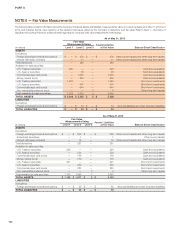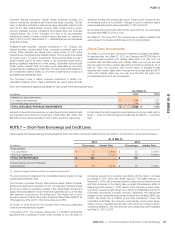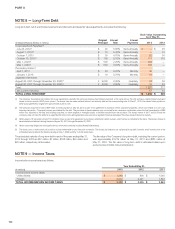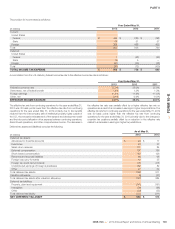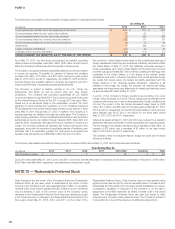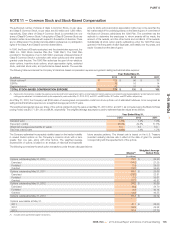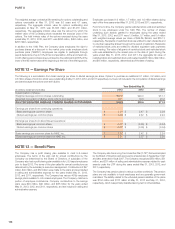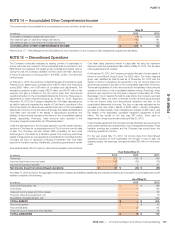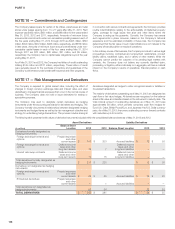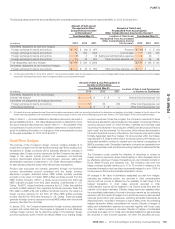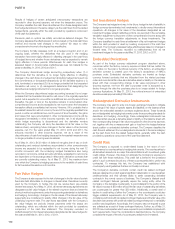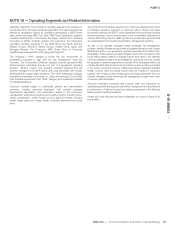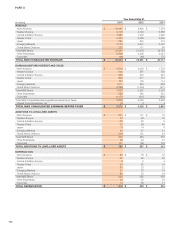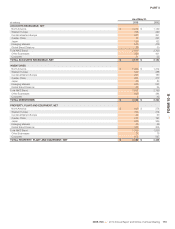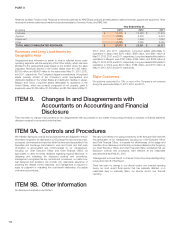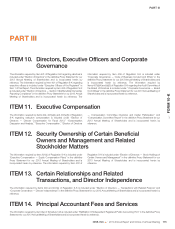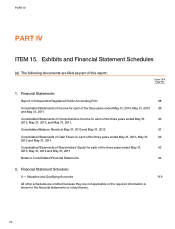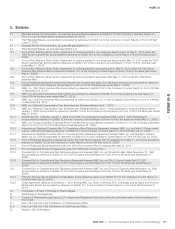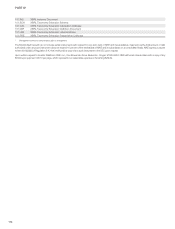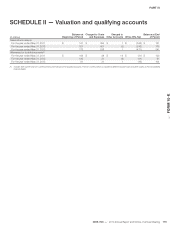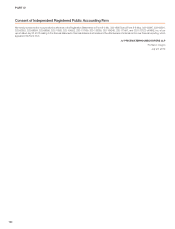Nike 2013 Annual Report Download - page 65
Download and view the complete annual report
Please find page 65 of the 2013 Nike annual report below. You can navigate through the pages in the report by either clicking on the pages listed below, or by using the keyword search tool below to find specific information within the annual report.PART II
Results of hedges of certain anticipated intercompany transactions are
recorded in other (income) expense, net when the transaction occurs. The
Company classifies the cash flows at settlement from these designated cash
flow hedge derivatives in the same category as the cash flows from the related
hedged items, generally within the cash provided by operations component
of the cash flow statement.
Premiums paid on options are initially recorded as deferred charges. The
Company assesses the effectiveness of options based on the total cash flows
method and records total changes in the options’ fair value to other
comprehensive income to the degree they are effective.
The Company formally assesses, both at a hedge’s inception and on an
ongoing basis, whether the derivatives that are used in the hedging
transaction have been highly effective in offsetting changes in the cash flows
of hedged items and whether those derivatives may be expected to remain
highly effective in future periods. Effectiveness for cash flow hedges is
assessed based on forward rates. Ineffectiveness was not material for the
years ended May 31, 2013, 2012 and 2011.
The Company discontinues hedge accounting prospectively when (1) it
determines that the derivative is no longer highly effective in offsetting
changes in the cash flows of a hedged item (including hedged items such as
firm commitments or forecasted transactions); (2) the derivative expires or is
sold, terminated, or exercised; (3) it is no longer probable that the forecasted
transaction will occur; or (4) management determines that designating the
derivative as a hedging instrument is no longer appropriate.
When the Company discontinues hedge accounting because it is no longer
probable that the forecasted transaction will occur in the originally expected
period, but is expected to occur within an additional two-month period of time
thereafter, the gain or loss on the derivative remains in accumulated other
comprehensive income and is reclassified to net income when the forecasted
transaction affects consolidated net income. However, if it is probable that a
forecasted transaction will not occur by the end of the originally specified time
period or within an additional two-month period of time thereafter, the gains
and losses that were accumulated in other comprehensive income will be
recognized immediately in other (income) expense, net. In all situations in
which hedge accounting is discontinued and the derivative remains
outstanding, the Company will carry the derivative at its fair value on the
balance sheet, recognizing future changes in the fair value in other (income)
expense, net. For the years ended May 31, 2013, 2012 and 2011, the
amounts recorded in other (income) expense, net as a result of the
discontinuance of cash flow hedging because the forecasted transaction was
no longer probable of occurring were immaterial.
As of May 31, 2013, $132 million of deferred net gains (net of tax) on both
outstanding and matured derivatives accumulated in other comprehensive
income are expected to be reclassified to net income during the next 12
months concurrent with the underlying hedged transactions also being
recorded in net income. Actual amounts ultimately reclassified to net income
are dependent on the exchange rates in effect when derivative contracts that
are currently outstanding mature. As of May 31, 2013, the maximum term
over which the Company is hedging exposures to the variability of cash flows
for its forecasted transactions is 24 months.
Fair Value Hedges
The Company is also exposed to the risk of changes in the fair value of certain
fixed-rate debt attributable to changes in interest rates. Derivatives currently
used by the Company to hedge this risk are receive-fixed, pay-variable
interest rate swaps. As of May 31, 2013, all interest rate swap agreements are
designated as fair value hedges of the related long-term debt and meet the
shortcut method requirements under the accounting standards for derivatives
and hedging. Accordingly, changes in the fair values of the interest rate swap
agreements are considered to exactly offset changes in the fair value of the
underlying long-term debt. The cash flows associated with the Company’s
fair value hedges are periodic interest payments while the swaps are
outstanding, which are reflected within the cash provided by operations
component of the cash flow statement. The Company recorded no
ineffectiveness from its interest rate swaps designated as fair value hedges for
the years ended May 31, 2013, 2012, or 2011.
Net Investment Hedges
The Company has hedged and may, in the future, hedge the risk of variability in
foreign-currency-denominated net investments in wholly-owned international
operations. All changes in fair value of the derivatives designated as net
investment hedges, except ineffective portions, are reported in the cumulative
translation adjustment component of other comprehensive income along with
the foreign currency translation adjustments on those investments. The
Company classifies the cash flows at settlement of its net investment hedges
within the cash provided or used by investing component of the cash flow
statement. The Company assesses hedge effectiveness based on changes in
forward rates. The Company recorded no ineffectiveness from its net
investment hedges for the years ended May 31, 2013, 2012, or 2011.
Embedded Derivatives
As part of the foreign currency adjustment program described above,
currencies within the factory currency exposure indices that are neither the
U.S. Dollar nor the local or functional currency of the factory, an embedded
derivative contract is created upon the factory’s acceptance of NIKE’s
purchase order. Embedded derivative contracts are treated as foreign
currency forward contracts that are bifurcated from the related purchase
order and recorded at fair value as a derivative asset or liability on the balance
sheet with their corresponding change in fair value recognized in other
(income) expense, net from the date a purchase order is accepted by a
factory through the date the purchase price is no longer subject to foreign
currency fluctuations. At May 31, 2013, the notional amount of embedded
derivatives was approximately $136 million.
Undesignated Derivative Instruments
The Company may elect to enter into foreign exchange forwards to mitigate
the change in fair value of specific assets and liabilities on the balance sheet
and/or the embedded derivative contracts explained above. These forwards
are not designated as hedging instruments under the accounting standards for
derivatives and hedging. Accordingly, these undesignated instruments are
recorded at fair value as a derivative asset or liability on the balance sheet with
their corresponding change in fair value recognized in other (income) expense,
net, together with the re-measurement gain or loss from the hedged balance
sheet position or embedded derivative contract. The Company classifies the
cash flows at settlement from undesignated instruments in the same category
as the cash flows from the related hedged items, generally within the cash
provided by operations component of the cash flow statement.
Credit Risk
The Company is exposed to credit-related losses in the event of non-
performance by counterparties to hedging instruments. The counterparties to
all derivative transactions are major financial institutions with investment grade
credit ratings. However, this does not eliminate the Company’s exposure to
credit risk with these institutions. This credit risk is limited to the unrealized
gains in such contracts should any of these counterparties fail to perform as
contracted. To manage this risk, the Company has established strict
counterparty credit guidelines that are continually monitored.
The Company’s derivative contracts contain credit risk related contingent
features designed to protect against significant deterioration in counterparties’
creditworthiness and their ultimate ability to settle outstanding derivative
contracts in the normal course of business. The Company’s bilateral credit
related contingent features generally require the owing entity, either the
Company or the derivative counterparty, to post collateral for the portion of the
fair value in excess of $50 million should the fair value of outstanding derivatives
per counterparty be greater than $50 million. Additionally, a certain level of
decline in credit rating of either the Company or the counterparty could also
trigger collateral requirements. As of May 31, 2013, the Company was in
compliance with all credit risk related contingent features and the fair value of its
derivative instruments with credit risk related contingent features in a net liability
position was insignificant. Accordingly, the Company was not required to post
any collateral as a result of these contingent features. Further, as of May 31,
2013 those counterparties which were required to post collateral complied with
such requirements. Given the considerations described above, the Company
considers the impact of the risk of counterparty default to be immaterial.
110


